Text
Tami Erwin, Executive Vice President of Wireless Operations at Verizon, Shares 12 Fundamental Leadership Attributes
1. Get things done. The first job of a leader is to act.
2. Balance focus on strategy and execution.
3. Provide the right tools and resources to face the problems your team might face.
4. Be visible to customers and employees. Engage with what is happening.
5. Communicate openly and honestly, both with employees and customers.
6. Exercise constructive dissent. Rally once a decision is made.
7. Lead by example. Do the tough things and be engaged when it matters.
8. Be passionate. Demonstrate a commitment to the objectives before you.
9. Believe in yourself – and others. Spend time being an iconic developer of people.
10. Celebrate success, even when the chips are down and the work is hard.
11. Maintain balance for yourself and those who support you. Give and get all that life gives you.
12. Give back. Identify and support emerging talent. As a leader, if you don't give back, who will?
340 notes
·
View notes
Photo
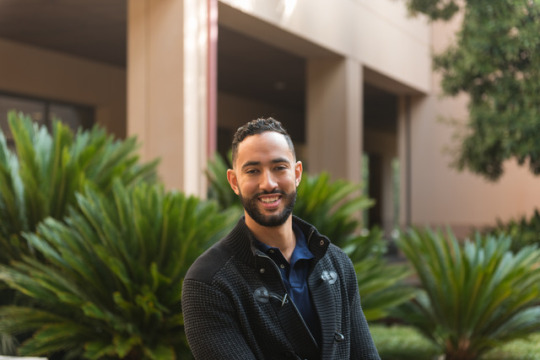
"Just ask—such a simple takeaway that I think will prove to be monumental with how I approach difficult work problems and interpersonal relations. At my previous organizations, I had been taught a culture that put a high value on showing what you knew. I derived from this a propensity to figure out problems myself, and first assert my conclusions rather than be open to the thoughts of others. To ask for help was to show weakness. At the GSB I have the space to try out different forms of interpersonal communication, and the opportunity to solicit honest feedback on how my behaviors affect others. It is amazing the amount to which you can learn from others’ perspectives. Even more surprising is their willingness to share them. I have found this true irrespective of how important or busy you may perceive someone to be, but the key thing is to not be afraid to ask. The GSB has helped me transition my mentality on asking for assistance. Asking for help is not a sign of weakness, but rather a product of humility in knowing what you know and what you don’t, and being brave enough to act on it." –Frank Ramírez (MBA ’17) Photo by Kiefer Hickman
94 notes
·
View notes
Photo

Last week, Stanford Professor and Baidu Chief Scientist Andrew Ng spoke on "Artificial Intelligence: Separating Hype from Reality" as part of the 2017 Stanford MSx Forum speaker series. Read more takeaways from the talk: http://stanford.io/2kNLcTZ
116 notes
·
View notes
Photo

"Two weeks after I arrived at the GSB, a friend told me I had imposter syndrome. Shortly after, I realized that many of my classmates shared that feeling – a sense that somehow we had landed at the GSB due to luck, rather than our accomplishments. But our anxieties haven’t paralyzed us. Instead, they’ve pushed us to be humble and to self reflect. A byproduct of our shared feeling has created an environment that drives us to continuously learn, develop, work harder, and support each other. No one here is comfortable coasting, and we are all better off because of it." –Aram Verdiyan (MBA ’17) #GSBinthemoment
View more portraits and reflections: stanford.io/2jbuvSO
54 notes
·
View notes
Photo
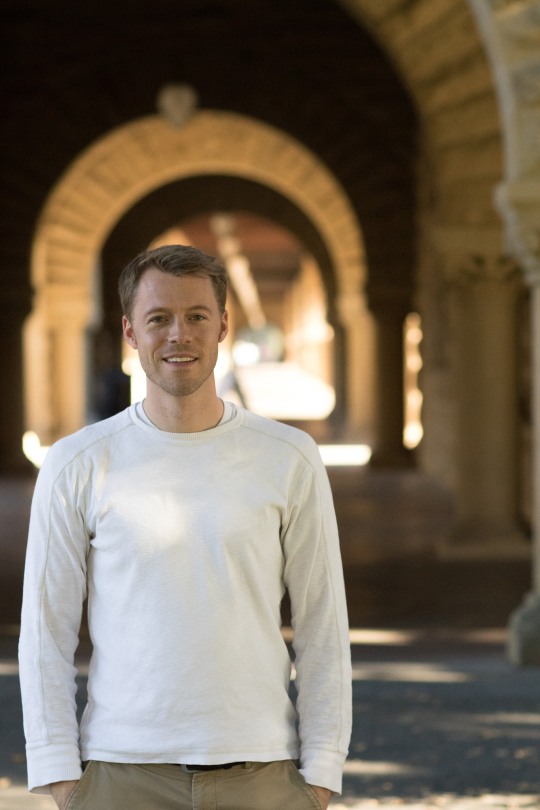
"'Yet' may be the most impactful word I’ve adopted while at the GSB. Let me explain. I came to the GSB to clearly identify my strengths and shore up known weaknesses. I wanted a list, something I could use to answer interview questions and address in performance reviews. I essentially viewed my strengths and weaknesses as more or less fixed. Sure I could make marginal improvements, but who I am and how I act was pretty well set by now. Wasn’t it?
I’ve learned that isn’t true. My weaknesses have 'yet' to become strengths (or at least not weaknesses). My strengths have 'yet' to be stretched in new ways. And actions I’ve never taken before have 'yet' to be employed in new settings. At the GSB I’ve learned that I can experiment with my behaviors and mindsets, and I've had many opportunities to experiment. My transition from a fixed to a growth mentality is ongoing but it has helped me do and become more than I am now." –Bryce Peterson (MBA ’17) #GSBinthemoment
View more portraits and reflections: stanford.io/2jbuvSO
Photo by Natalie White
48 notes
·
View notes
Photo

"In life, there are certain decisions, certain moments and certain experiences that will have the power to define who you really are and shape your future; coming to the Stanford GSB's MSx program is definitively one of those life defining moments. It's a unique opportunity to surround myself with some of the most brilliant people (faculties, fellows, business leaders), be humbled and learn from them about varies topics: leadership principles, strategy framework, technology evolution, and future vision. It's a wonderful journey to embrace life full of possibilities. It inspires me to be a better version of myself, to be someone bigger than who I was, and to do more than just exist." –Yan Gao (MSx ’17) #GSBinthemoment
Photo by Kiefer Hickman
46 notes
·
View notes
Photo
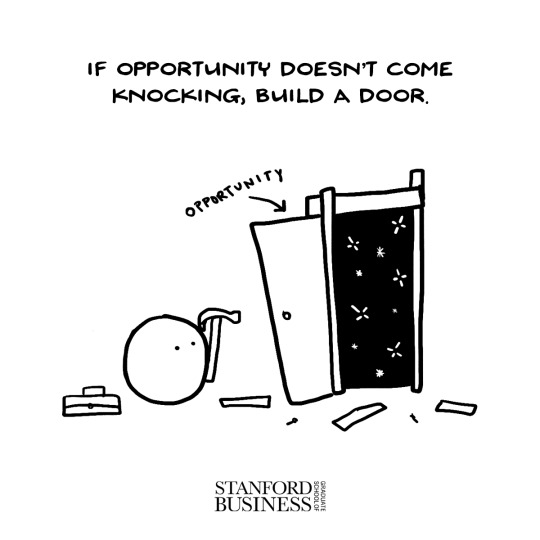
Entrepreneurs, push past the naysayers: http://stanford.io/2e7zeob
246 notes
·
View notes
Text
Why It’s Hard to Make Long-Term Public Investments
“The world and our country face a lot of pressing problems,” stated Professor of Political Economy Neil Malhotra at the start of his recent session for the 2016 Stanford Executive Program. Just a few examples include climate change, collapsing infrastructure, public/private pensions, and disaster management. And these problems all have something in common: They are long-term challenges that have costs today.
Societies – especially democracies – really struggle in tackling these tough, persistent problems. In one study, Professor Malhotra found that “voters reward politicians for relief but not preparedness spending.” This can create incentives where politicians write more relief checks versus investing in disaster preparedness – even though research has shown $1 in preparedness saves $15 in future damage.
So why does this happen? Professor Malhotra explored six reasons why it’s difficult for societies to make upfront investments for upcoming challenges:
1. Short-Sightedness. “In all aspects of their lives – even when the stakes are high – people discount the future,” noted Professor Malhotra. Diet and exercise are a clear example: We do what feels good today because the cost won’t show up for many years in the future.
2. Generational Theft. Another reason why people might not invest in the future is because they know they may not be there. And the people who will be there are not yet old enough to vote.
3. Observability. It’s hard to observe what the effect of long-term investments will be, while something like a relief check is very tangible. “Terrorism mitigation is one of the exceptions. People are for it because it’s very observable and you can see it being done – therefore the U.S. spends a lot of money trying to address terrorism. It’s not the same for other long-term investments.”
4. Temporal Attribution. This is when people place the blame on the incorrect root cause. For example, when facing a fiscal crisis, it’s easy to point a finger at the current politician even though a former leader’s actions may have actually put the state or country in its current situation.
5. Counterfactuals. What will the world look like if this long-term problem did or didn’t happen? For example, if Hitler was shot in year X, what would have happened? When people have to vote for a long-term investment, they have to run a counterfactual statement like this in their head. This concept is hard for the human mind to grasp.
6. Uncertainty Aversion. People hate any uncertainty in the world. When uncertainty is introduced, people just don’t like it and don’t want to deal with it.
Professor Malhotra ended the class by having students think about insurance as a possible solution. Many sovereign countries don’t invest in preparedness because they depend on international organizations such as the World Bank and the United Nations to help them out if a disaster hits. “What if instead of the World Banks giving loans and grants after a disaster, they make the countries buy insurance?” proposed Professor Malhotra. By mitigating risk via insurance, premiums go down. It could allow countries to balance their budgets today. Insurance helps pool risk, but another aspect is that it also allows you to capture future value today via the lower premiums.
Read more of Professor Malhotra’s research here.
86 notes
·
View notes
Text
Cyber Threats Are Growing More and More by the Day
Cyber threats are growing more and more by the day: 97 percent of Fortune 500 companies estimate that they have been breached. Yet 205 days often go by between when a breach occurs and the victim discovers it.
“There are only two types of people and companies: those who have been breached, and those who haven’t realized it,” shared Hoover Institution Senior Fellow Amy Zegart in her recent cybersecurity talk for the 2016 Stanford Executive Program. “The cyber environment is very confusing, we’re told to be afraid all the time.”
How can cyber threats be deterred? Are there any lessons we can learn from U.S. history in navigating these types of attacks? Why can it feel like there is still a shroud of mystery surrounding them?
Zegart sketched out the state of the cyber landscape:
What We Should Know
Looking at cyber security through the lens of U.S. history, it’s clear that this is an unprecedented threat. If you think about the Cold War, noted Zegart, the danger was much more straightforward. Policymakers faced a single advisory – the Soviet Union. They knew who it was, where it was located, and also had a pretty good idea of its intentions and capabilities.
Today’s threat landscape is more crowded and dynamic. “There are rising states, declining states, rogue states, non-state actors, ISIS, and transnational threats like global climate change.” And it’s changing faster than ever before. For example, in 2007 the U.S.’s Threat Assessment did not mention “cyber attacks” even once. In 2009, it appeared extremely far down on the list. Then suddenly in 2012, cyber jumped into the top three threats and has remained there since.
What We Do Know
Cyber threats are different from other national security threats in a few ways.
When it comes to military threats, the countries with the most capabilities to protect their land and sea are the most powerful. But on the cyber side, having the most capabilities can actually make you the most vulnerable. The U.S. has the best cyber resources, but because we rely so much on networks, there is an incredible amount that can be disrupted. Poorer countries that aren’t online very much have less that can be threatened. In this way, the U.S. cyber environment is a source of both strength and vulnerability – and overall complication.
Another element that sets cyber threats apart is that the government can’t go it alone in tackling them. In every other realm, the government is the monopoly provider of protection services – like police are the societal providers of security. The government needs the support of technology leaders, but there is a major trust deficit between the two that is only getting worse.
In addition, the attack surface of cyberspace is huge and only getting bigger; there are now more devices connected to the internet than there are people on the planet. The danger is that every “smart” device is an attack point into your life. “Yet we’d rather be connected than protected,” reminds Zegart, “and that’s why the attack surface expands.” The code in our devices has inherent vulnerabilities, but humans are always the weakest link. Eighty percent of cyber breaches are from stolen passwords.
What We Don’t Know
Zegart examined three common questions about cyber security:
Question #1: What type of cyber attack constitutes a national security level threat in the U.S.?
The short answer is we don’t know yet. “‘Cyber’ and ‘attack’ are problematic words,” shared Zegart. Cyber can mean a wide-ranging spectrum of things that share a common mode of execution on digital networks and systems. By using the word “cyber” we loop together in one category theft of personal information along with espionage and theft of intellectual property. “It’s like saying ‘vehicle-born threats’ for example, and under this category lumping together road rage, carjacking, invasions by tanks, and terrorist attacks by truck bombs,” she explained.
We just don’t have a good lexicon for understanding these threats. Why should we care about the specific words used to describe them? “Because words matter when it comes to government action. The words you use trigger government actions and shape the public’s expectations of what to do.”
Question #2: How serious are teenage hackers?
“We have much less to fear from teens than major other actors,” said Zegart. “We often hear in the news about ‘sophisticated’ cyber attacks that aren’t really that clever, but it was good PR for the victim to say that the perpetrator was ‘an advanced persistent’ threat.” In actuality, the victim likely just didn’t see the threat coming and now can’t get rid of it. Serious cyber threats come from China, Russia, Iran, and North Korea.
Question #3: Is cyber deterrence possible?
Deterrence means threatening to punish an adversary in order to prevent them from doing something. “In order to deter, you have to know the culprit. Knowing who you’re negotiating with makes all the difference – and it’s getting harder and harder in the cyber world.” Even if you can find out the computer that is responsible for an attack, you then have to get to the person behind it. Speed matters. If you can’t identify the culprit quickly, you can’t punish well. Because of this, deterrence is not a quick fix or a good solution for cyber threats. “We need to start by asking the right questions,” emphasized Zegart.
For more from Amy Zegart, follow her on Twitter: @AmyZegart
44 notes
·
View notes
Photo
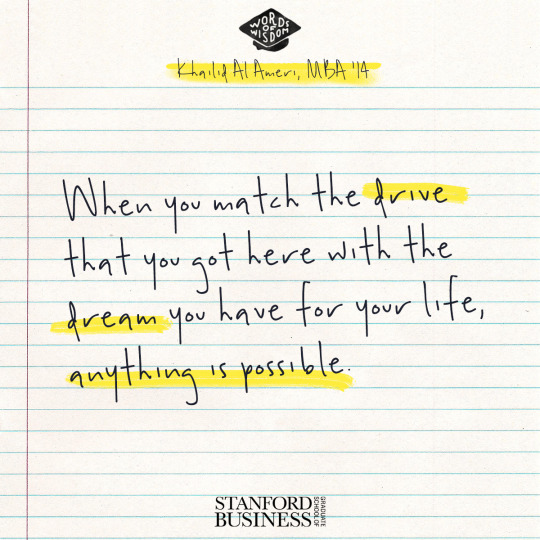
Welcome new MBA students! Start fall quarter with words of wisdom from Khalid Al Ameri (MBA ‘14).
99 notes
·
View notes
Text
Lessons in Social Entrepreneurship: Test Fast & Pinpoint Pain Points
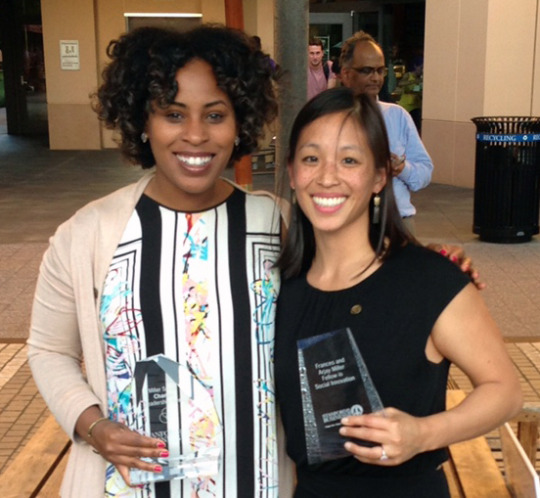
Through their education nonprofit MindRight, Ashley Edwards and Alina Liao (both MBA ’16, pictured above) are working to help at-risk youth recover from trauma caused by exposure to community violence and other poverty related barriers. Below, the Stanford GSB graduates share the experiences that led them to launch their startup and offer tips for others pursuing their own entrepreneurial journey.
Can you share a story or two about the path that led you to become social entrepreneurs?
Ashley: “My dad used to share stories with me about his time growing up in Newark, New Jersey where he was exposed to violence and crime on an almost daily basis. Years later, when I returned to Newark to work in education as director of operations of a charter high school, I saw my students face the same daily obstacles that my dad faced growing up. Nothing had changed decades later. Many of my students suffered from trauma from exposure to daily violence, never received help because of our school’s limited resources, and had to beat incredible odds to escape a cycle of poverty. I have a personal conviction to ensure that no other child has to grow up that way. Social entrepreneurship is a way for me to make that conviction a reality.”
Alina: “Before the GSB, I led a transformation of the organizational structure of the consulting firm where I served as vice president. This experience got me thinking about a future in entrepreneurship. In my free time, I tutored low-income youth in Washington, DC. I was both inspired by the potential of the kids I served and angered by the failures of the status quo to provide them with basic needs that all children need to thrive. I went to the GSB to change careers and explore how I could make an impact for underserved youth. The classes Startup Garage and Social Venture Practicum helped me discover that being an entrepreneur allows me to channel my strengths and past experiences into what matters to me most - unleashing the brilliance of at-risk youth.”
What are some entrepreneurial lessons you've learned so far as you're working on your education nonprofit?
Lesson #1 “Throughout our journey, we’ve learned the importance of testing fast. Before we had any technical platform built, we were able to test our user experience and value proposition by simulating the experience of the technology we envisioned. We decided to start texting users manually ourselves to start receiving feedback on our basic idea, before we even decided whether we would create a mobile app or a texting platform. This helped us hone in on our current product of an SMS texting platform. By doing this, we were able to gain valuable insights on our user experience before spending significant resources on product development.”
Lesson #2 “We’ve also learned the importance of narrowing the pain point of our target users. Untreated PTSD and traumatic stress in under-served communities is a huge, complex problem. Naturally, we were pulled in many directions in our early ‘ideation’ stage. However, by speaking with the youth we serve, we gained a more nuanced understanding of the barriers that keep at-risk youth from getting help. We heard repeatedly from teens living in areas with a high prevalence of trauma, ‘you’re just expected to live this way.’ This narrow pain point we uncovered revealed a crucial barrier in getting youth the help they need. We were able to design a targeted solution around helping youth better understand what trauma is and that they can overcome it with the right skills. We’ve since received validation from our early users.”
How do you come up with new, creative ideas? What inspires you?
“The youth we serve continually inspire us to do our work. Teens from South Los Angeles to Newark are incredibly creative, artistic, and resilient people, as we’ve witnessed through our daily interactions to help them tackle adversity in their lives. By holding focus groups and embracing user-centric design, we are continuously inspired by their stories and able to use their feedback to generate new ideas to meet their needs.”
Learn more about MindRight here.
youtube
67 notes
·
View notes
Photo
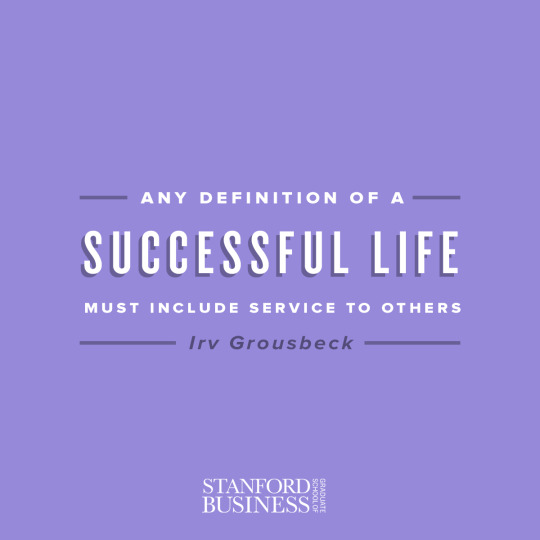
Irv Grousbeck on finding your way on the entrepreneurial path: http://stanford.io/29g3U3m
146 notes
·
View notes
Photo

Sam Kamara (MBA ’15) explores how mindfulness can lead to better decision-making for individuals, corporations, and countries: http://stanford.io/1UQLeaF
99 notes
·
View notes
Text
10 Strategies to Motivate Employees and Keep them Engaged

People are your company’s biggest asset. But how do you build a culture such that employees feel both valued and productive? Below you’ll find a combination of personal maxims and principles from prominent Stanford GSB alumni, faculty, and guests that may guide you in building a company that employees love working for.
Which strategies resonate with you? Tweet us @StanfordBiz.
1. Hire People with the Right Attitude
Ensure that your hiring process is set up to catch employees who share your values - and to let go of those who don’t. 2016 was Four Seasons Hotels and Resorts’ 19th consecutive year on Fortune magazine's list of the 100 Best Companies to work for, and founder Isadore Sharp says this is a product of the firm’s hiring process. "Competence we can teach; attitude is ingrained."
Read more here: stanford.io/1Q1LrsM
2. Make Your Company a Community
Build a culture where employees are encouraged to participate. Kent Thiry, CEO of DaVita HealthCare Partners, is known to don a Three Musketeers costume at company meetings and lead employees in chants of “All for one and one for all.” He also uses voting as a way to spark a discussion - but notes that as CEO, you should retain the right to overrule. "It’s the discussion that matters,” he says.
Listen here: stanford.io/1PgzkRo
3. Recognize that Stock Options Don’t Always Work
Contrary to popular belief, financial incentives like stock options or commissions aren't effective motivators, says Stanford GSB Professor Jeffrey Pfeffer. Management often see these incentives as a quick fix to worker morale, but what needs to be changed is much deeper - organizational culture, employee mindsets, or company values. Incentives should be used not to drive behavior but instead to provide recognition and to share the company's success with its employees.
Read more here: stanford.io/25W8tZE
4. Create a Compliment:Critic Ratio
Management and psychological research shows there might be an ideal ratio between complementing and correcting, such as 3-to-1 or 5-to-1. At a panel discussion moderated by Mandy O’Neill, (PhD ’05), organizational scholar Kim Cameron noted that there has to be some room for negative feedback, but the important thing is that the ratio to be skewed to the compassionate. Negative feedback, when doled out in a constructive way and in appropriate proportions, is important for building an environment in which employees can thrive.
Read more here: stanford.io/1rog149
5. Emphasize Equality
Early-stage companies must find ways to balance giving workers a voice with organizational needs for greater structure and hierarchy. With increased formalities comes the risk that employees feel lost or unimportant. Good leaders find a respectful way to communicate their position while preserving the spirit of equality, advises Professor Lindred Greer. Be open to feedback and, most importantly, act on the feedback you receive. Founders who maintain a humble management style and share credit for successes will empower employees.
Read more here: stanford.io/25zqOYC
6. Challenge Employees to Disagree with You
Leaders can create an environment where their teams feel comfortable challenging ideas and having a constructive conversation that betters the overall project. For example, before Tyra Banks hires someone, she tells them, “You will not stay in this position if you continue to say yes to me for every single thing. I need you to change my mind 70% of the time. There will be 30% of the time that I will say, ‘No, we’re going to do it this way because this is what I want to do,’ but I need you to be more clever than me 70% of the time.”
Read more here: stanford.io/29UvDK9
7. Define, Discuss and Reinforce Roles
When high-powered people work with teammates who are a potential threat, the high-powered people lash out. Companies that ignore these power struggles eventually pay the price through loss of potential, disgruntled employees, and outright conflict. Firms can mitigate this with increased clarity, for example announcing successor for outgoing executives. Teams in which people's perceptions of their own power match their teammates' perceptions of it, perform better.
Read more here: stanford.io/1VXLzL8
8. Cultivate and Reward Your Top Performers
Although General Electric's "20-70-10" system — which methodically manages out the bottom 10 percent and promotes the top 20 percent of employees each year— has been controversial, former CEO Jack Welch emphatically defended it at a talk at Stanford GSB. "You should take the top 20 percent of your employees and make them feel loved," Welch advised. "Take the middle 70 percent and tell them what they need to do to get into the top 20 percent." Give your company's top performers the right combination of rewards and recognition by hosting small celebrations or inviting them to trainings.
Watch the video here: stanford.io/1VXMkUq
9. "You Catch More Flies with Honey."
Andy Dunn, founding CEO of Bonobos, models his leadership style after this piece of advice he received from Professor Joel Peterson. “You condition people to embody the very qualities you are praising,” he says. "When I started to do this, it created an environment where it is OK for people to offer recognition to their direct reports. Slowly, the culture began to flourish."
Read more here: stanford.io/1rognYG
10. Use Big Data to Track, Measure, and Assess Employees
Thanks to the widespread adoption of software and database systems, companies can manage and reward talent, assess employee productivity, and evaluate HR programs better than ever before. Google’s People Science team, for instance, has quantitatively analyzed what makes some Googlers better managers and what types of pay (salary vs. bonus) employees value most. Leader who are early adopters of these tools can use them to make their workplaces more efficient, writes Professor Harikesh Nair.
Read more here: stanford.io/1Ypn1Ld
__
Anna von Wendorff is a Social Media Intern at the Stanford GSB. She helps analyze and develop Stanford GSB social media.
166 notes
·
View notes
Photo

"In his farewell commencement address last Sunday, President Hennessy said, 'Nothing gives us, as your teachers and mentors, greater joy than to see a former student succeed.' Indeed, there is something special about teaching what I know to my three young sons and watching their passions blossom. Witnessing them inherit something as simple as my love of skiing brings me great joy." –Craig Klein (MS ’16)
View more photos and reflections from the Class of 2016: http://stanford.io/1T2bT3e
Photo by Natalie White
6 notes
·
View notes
Photo

Catherine Chien (MSx ’16) reflects on her Stanford GSB experience: "The GSB impressed upon me that business is really about a philosophy on life. I saw this time and again – David Dodson's playground rule that 'sharing is not about giving a portion of your surplus... but giving something that you want to keep to another person who needs it more', Rob Siegel's advice to 'always assume good intent', Matt Bannick's question whether we felt 'entrusted with or entitled to our privilege', Bill Meehan's call to 'serve lives, serve organizations, serve the world', our MSx slogan 'No Sloan left behind', the kindness of many a GSB-er... I am very grateful to be part of this collaborative, creative and passionate fabric, and excited to bring this spirit with me as I venture forth."
View more #gsbinthemoment student portraits and reflections: http://stanford.io/1T2bT3e
Photo by Natalie White
39 notes
·
View notes
Photo

"The most important lesson I’ve learned at the GSB is about change: How to change yourself to deal with changes as a person, as a leader. Changes are constant in our world. I used to think that I knew this pretty well until I came to the GSB. Embracing changes is not only a mindset. It takes tremendous courage, positivity, dedication, discipline, integrity and resilience to face changes and take them head on. It’s exactly like Philip Knight’s inspiring words carved on the GSB ground, “There comes a time in every life when the past recedes and the future opens. It’s the moment when you turn to the unknown.
Through my 'Touchy Feely' class, I’ve changed to be less judgmental and more curious. Through my 'Path to Power' class, I’ve learnt to be constantly aware of the changes around you and respond to them positively instead of passively complaining about and resisting them. Through my 'Managing Growing Enterprise' class, I’m deeply touched by the optimism and resilience exemplified by so many entrepreneurs when they face difficult changes. I've changed to embrace uncertainties and try to make a difference in the midst of them. Because I've realized that this is the only way to make a change happen and leave a footprint in this world." –Dandan Wu (MSx ’16)
View more #gsbinthemoment student portraits and reflections: http://stanford.io/1T2bT3e
Photo by Natalie White
20 notes
·
View notes